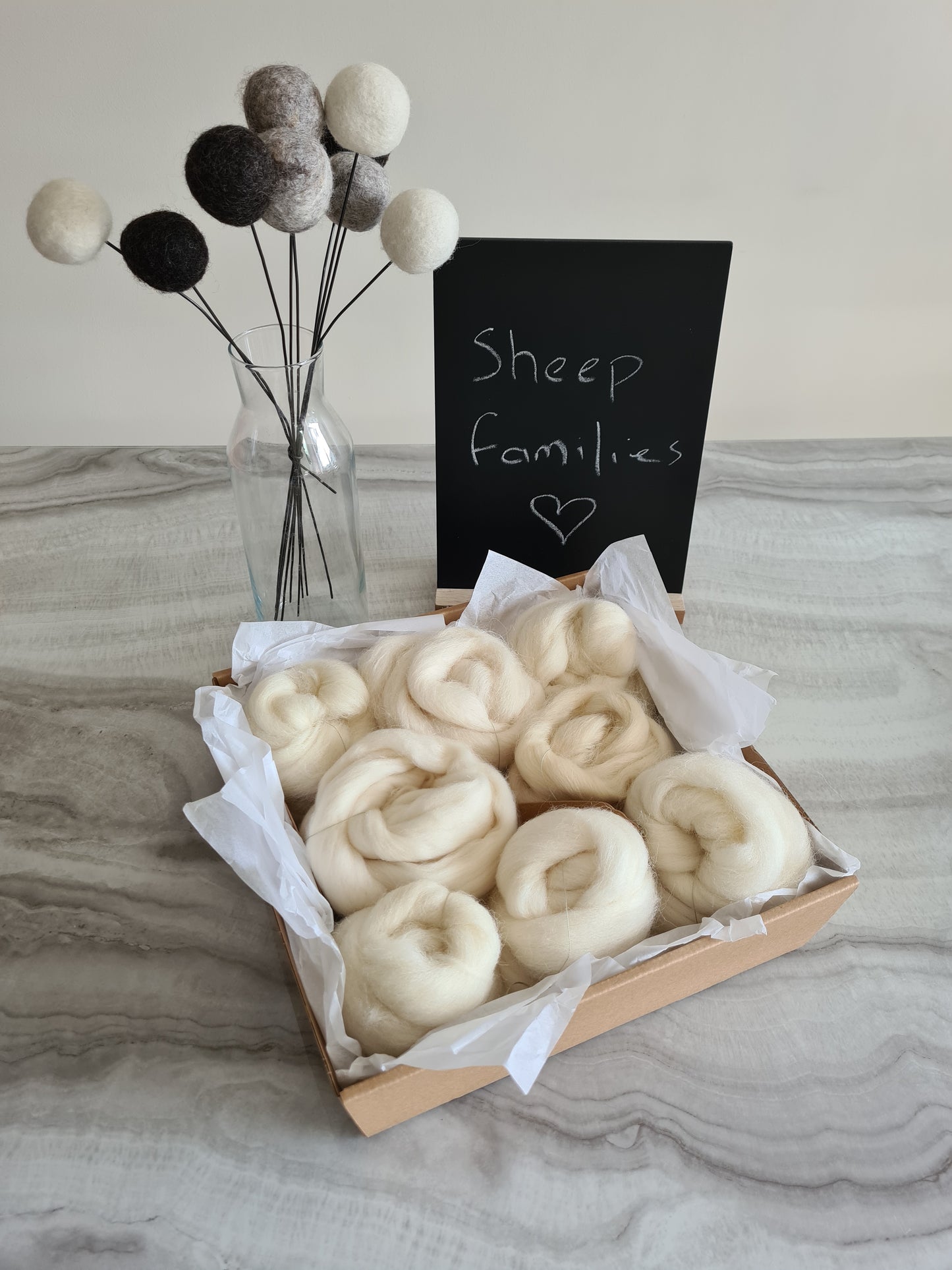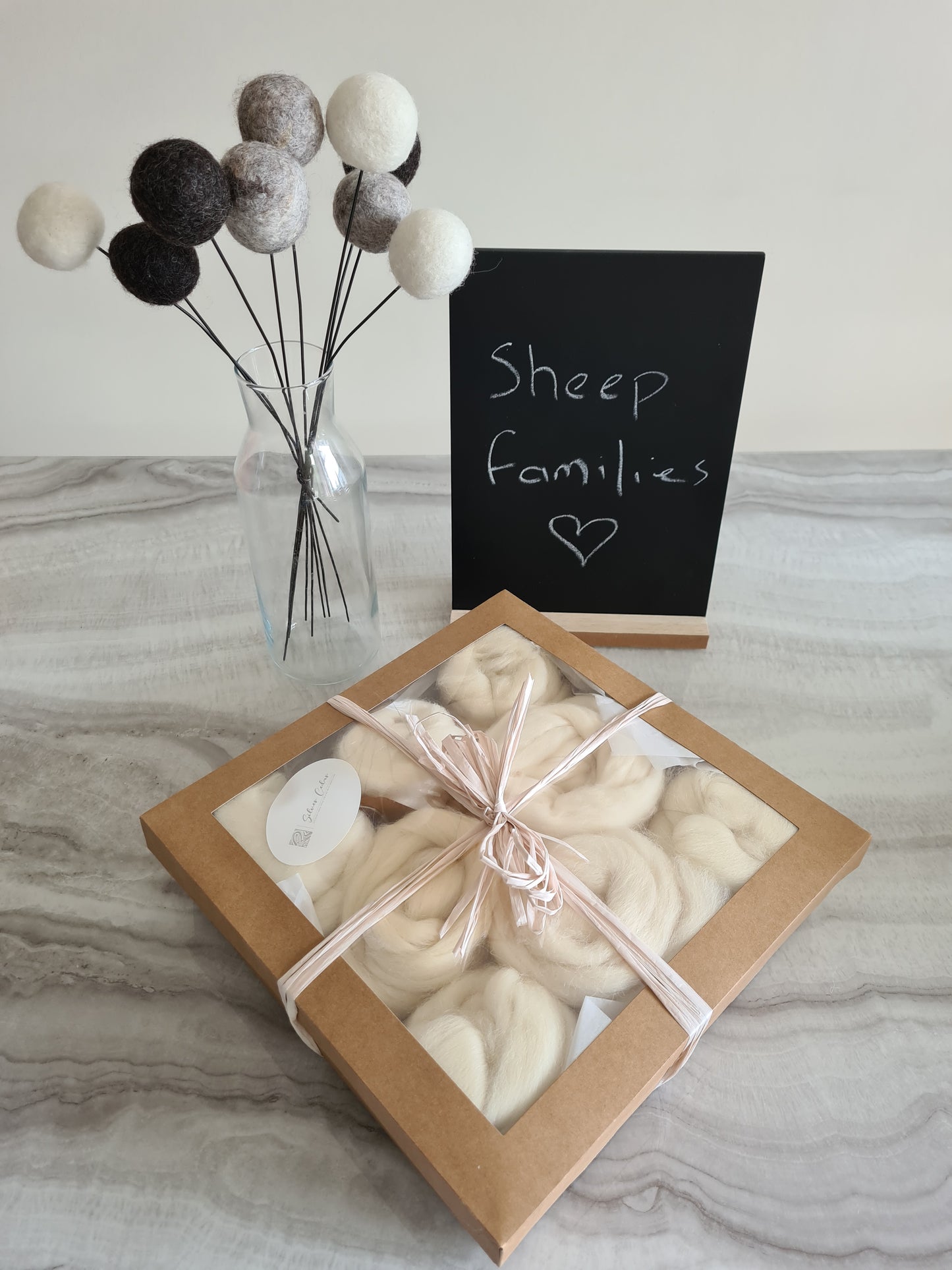Silver Cedar
The Sheep Families Box
The Sheep Families Box
Couldn't load pickup availability
Sheep Families Box
Putting a number on sheep breeds worldwide is almost impossible but experts put the figure at around 1,400. It’s also estimated that a third of sheep breeds, with their unique fibre qualities, are in danger of extinction.
Our sheep families box includes one 50g sample of top from each of eight sheep families:
- Lonk
- Cheviot
- Dorset Horn
- Shropshire
- Lincoln
- Rambouillet
- Icelandic
- Lleyn
Sheep family information:
Lonk (Conservation Breed) - Blackfaced Mountain Family
This family includes Dalesbred, Derbyshire Gritstone, Lonk, Rough Fell, Scottish Blackface and Swaledale and comes from the hill country of northern England, Scotland and Wales. Documentation and textiles indicate the family is at least 800 years old with agricultural historians considering the Lonk and Swaledale to be the oldest breeds of the group.
Cheviot - Cheviot Family
Traditionally there were three Cheviot breeds: the Border Cheviot (now Cheviot), Brecknock Hill Cheviot (Welsh) and the North Country Cheviot of the Scottish Highlands. The family name comes from the Cheviot hills which run along the border of England and Scotland. The history of these sheep is unclear and rumour is they came ashore after a Spanish ship ran aground in the 14th century and may have mixed with the Lincoln Longwool. Cheviots were imported into America in 1838 new breeds such as the American Miniature Cheviot have popped up.
Dorset Horn (Conservation Breed) – Dorset Group
There is speculation that the Polled and Horned Dorset’s came into being through crossing Spanish Merinos with native Welsh sheep. Polled (hornless) Dorset sheep were developed between the 1940s and 1960s separately in Australia and America, with additional crossbreeding, and are now far more common that the Dorset Horn. Dorpers which are a shedding bred or ‘hair sheep’ originated from crossing Dorset Horn rams with Blackhead Persian ewes and are increasingly popular as meat sheep for small farms given they don’t need to be shorn.
Shropshire (Conservation Breed) – Downs Family
Down’s sheep are sheep that originated in the 19th century in the downlands of southern England. They include Dorset Downs, Hampshire Downs, Oxford Downs, Shropshires, Southdowns (babydolls) and Suffolks. In South-west England on the board of Wales Southdown rams were introduced to native sheep and were a recognisable breed by 1853. At Silver Cedar we have two delightful Shropshire lads and their small stature makes them perfect for cleaning up around the orchard.
Lincoln – (Conservation Breed) English Longwool Family
This family has given so much to sheep breeding and fibre development over the centuries. Historians believe that the longwool family has a common ancestor brought to England by the Romans when they occupied it in 43 – 410 CE. The family includes: Bluefaced Leicester, Border Leicester, English Leicester, Cotswold, Greyface Dartmoor, Whiteface Dartmoor, Devin & Cornwall Longwool, Lincoln long wool, Romney, Teeswater and Wensleydale. The Lincoln Longwool is a large but gentle animal and produces a heavy, long and lustrous fibre.
Rambouillet – Merino Family
In the 12th and 13th centuries Spanish Royalty imported rams from a tribe of Arabic Moors called the Beni-Merines who were centred in what is present day Morocco. When crossed with the Spanish ewes the resulting wool was fine and soft. This was the foundation of the Merino breed and continued to be refined and in the middle ages the export of Merino sheep outside of Spain was punishable by death. However, this ban was lifted during the 1700s and some Spanish monarchs provided breeding stock to their relatives in European courts. In 1786 Louis XVI, husband of Marie Antoinette, imported 359 Spanish Merinos to his estate at Rambouillet in northern France. A breeding program continued there which resulted in a distinct Merino breed, the Rambouillet. Key Merino breeds include: Debouillet, Delaine Merino, Peppin Merino, Saxon Merino and Rambouillet.
Icelandic - Northern European Short-Tailed Family
The breeds in this family originated across islands throughout the North Atlantic, Scandinavia and Northern Russia. Some feral populations of this breed still exist in remote and rugged locations. One trait of this family is that many members are dual coated having a finer undercoat and hairy outer coat. The Icelandic breed is one of the worlds purest sheep breeds developing in isolation after Vikings settled Iceland between 870 and 930 CE. This sheep family includes: Boreray, Castlemilk Moorit, Finnsheep, Gotland, Hebridean, Icelandic, Manx Loaghtan, North Ronaldsay, Ouessant, Romanov, Shetland and Soay
Lleyn - Welsh Hill & Mountain Family
The Welsh Mountain sheep breeds are small and hardy sheep. They spend April to October grazing in the mountains and the winter in lower valleys. The Lleyn was developed through the cross of the extinct Irish longwool Roscommon rams and native Welsh ewes in the 1700s. In the early 1800s Border Leicester bloodlines were introduced also resulting in what is known as the Lleyn today. The Welsh Hill and Mountain Family includes: Badger Face Welsh Mountain, Balwen Welsh Mountain, Beulah Speckled Face, Black Welsh Mountain, Hill Radnor, Kerry Hill, Llanwenog, Lleyn, Welsh Hill Speckled Face, Welsh Mountain and South Wales Mountain breeds.




